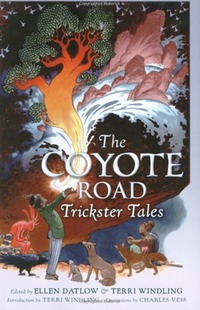I've been asked a number of times why I chose Coyote as my online identity/avatar/totem. The answer is very clear in my mind, but not so easy to express to those who aren't familiar with Coyote. I read (and occasionally heard) Coyote tales at a young age. In college I studied the broader Trickster motifs as well. Then for many years they lay dormant in my mind, until I reached a time when I needed to change who I was.
Coyote resonates within me; with where I am in my life. I first realized it a little over a year ago, when I was reading a number of stories and books by Charles de Lint. Coyote wanders in and out of de Lint stories, just as he meanders through "traditional" folk stories. I went back and re-read the earlier Coyote tales I knew, and I realized that I identified with Coyote's constant desire to get involved and fix things, and his equally common failure to get it right. That's not surprising, because Coyote is really a representation of what it means to be human; sometimes selfish, sometimes selfless, but never static. Humans are the Creator, the Fixer, the Breaker, and the Learner. Coyote's not so great at the Learning part, but then, neither are humans.
None of this makes a lot of sense unless you know something about Coyote beyond his penchant (in modern fable) for chasing Road Runner—although in truth, even those cartoons capture some of his essence. Coyote is a Trickster, in the mythic sense of the word. The Trickster appears in many cultures in many shapes. If you step out of Native American traditions (where he also may be Raven or Rabbit), you'll find him as Hermes in Greece, Legba in Africa, Loki to the Norse, Puck in England, Maui in Polynesia, and Anansi in the West Indies. There's a lot more to be said about Coyote, not the least of which is that any stories you may have learned in school, about any of those Tricksters, probably left out the profane, lecherous and scatological elements that laced the original versions. However, I'll take a shortcut here and quote a small portion of an existing description of Coyote.
…Trickster is a paradoxical creature who is wily and clever, yet also very foolish; he is both a cultural hero and a destructive influence, usually at one and the same time. Mythic tales about Trickster are often funny, but don't mistake him for a harmless buffoon. Trickster can be dark and deadly to encounter. At the very least he'll deceive or rob you blind; and even the gentlest brush with Trickster is likely to turn your life upside down. Trickster is a boundary crosser, a violator of rules, an agent of change and transformation.… [R]emember the double aspect of his nature: he is both good and bad, both wise and witless, both sacred and profane.… It is Trickster's role to shake things up, to ignore established conventions, and to transgress traditional boundaries, thereby initiating acts of change and transformation, for good or for ill.
…
To be on "the coyote road" in Native American legends means to be headed to a wild, unpredictable, and transformative destiny…to follow the path of Trickster, which is neither a safe nor comfortable place to be. Walk warily. He may rob you of the things you love most, or gift you with the things you most need. Or both. But one thing's certain. He's going to shake you up. And probably have a good laugh about it, too.
—Ellen Datlow and Terri Windling, in the preface and introductions to their anthology of modern trickster tales, "The Coyote Road".
I am on the coyote road.

